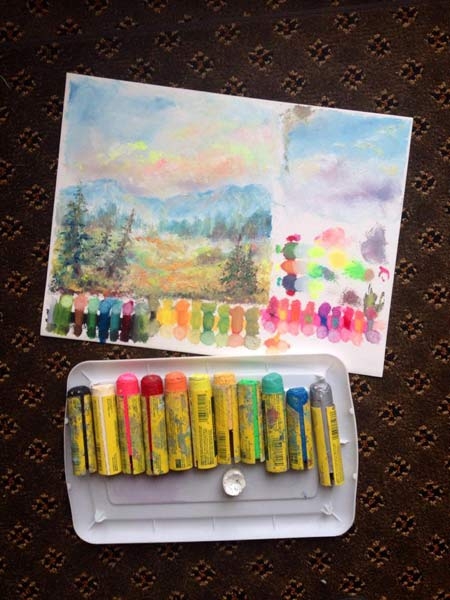
Colorado artist Marianna M. Duford has found success in various pursuits but has never followed a traditional path. So it’s not surprising that recently she dabbled with a decidedly unconventional medium: cattle markers.
The beefy oil sticks are meant for ranchers who need to mark their cattle, sheep, or horses with a color that sticks and stands out. They are properly called All-Weather PaintStiks, they are non-toxic and oil-based, and they cost a whopping 85 cents apiece. “They are not the finest quality,” says Duford. “I don’t know how fugitive the colors are, but I have one painting that’s 10 years old that looks fine.”

An example of a painting by Duford using the PaintStiks
Duford keeps the cattle markers in a Tupperware container. They skin over — so much so that she has to use a box cutter to peel off the dried portion at the end. Duford also uses a box cutter to fashion a point or edge at the end for drawing with more detail. “You can’t really go into much detail,” she says. “It’s a little unwieldy. They are a little finicky, and just funky.” Duford has 13 colors, and she thinks that’s about all that are available. This includes several fluorescent colors, and silver. “The silver does some nice graying with the other colors,” she says. The artist cuts off a bit of two or three colors with her palette knife and blends them with Gamsol and a stiff brush to tone down their vivid nature and to make color mixtures.
She’s not the first to paint with cattle markers: Duford has seen paintings in galleries of ranch scenes, cows, and horses fashioned from the oil sticks.

“The Way to Bodega Bay,” by Marianna M. Duford, oil, 5 x 7 in. She doesn’t usually paint with cattle markers!
These pigment sticks are not made for fine art; they’re made for utility on a ranch. “Some of the yellows I have might be the same yellow from the manufacturer, but just different because they came from different batches in the factory. I don’t think there’s a huge amount of quality control with these,” she says. Still, Duford suspects they may be great tools for plein air painting. After all, they are meant to be used outside and exposed to the elements.
“It’s a little interesting trying to tame some of the colors,” she says. “People into whimsy and bright colors would love them.”




